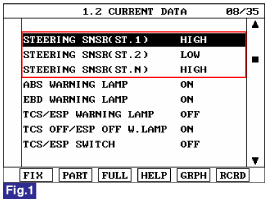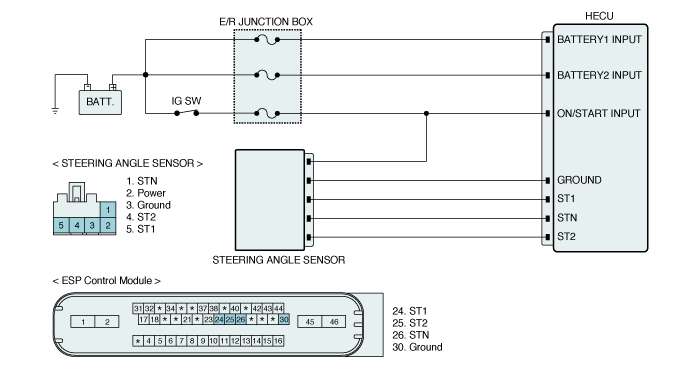Monitor the "STEERING SNSR" parameters on the Scantool.
Specification : If the parameters are changed according to wheel position during steering the wheel, it is normal condition.

Fig 1) Test Condition : Ignition "ON" & Engine "ON".
Normal Data
The Steering wheel angle sensor uses two sensors ( A-sensor and B-sensor ) to determine the direction of the rotation.
The main components of each sensor are LED, photo transistor and slit plate.
The slit plate, which has 45 holes, is installed between LED and photo transistor, and generates signals if slit plate rotates according to the steering wheel rotation.
The sensor signals are generated by photo transistor which is driven whenever the light passes through the holes. The HECU detects operating speed and direction of the steering wheel by this input signal, and the signal is used to input signal for anti-roll control.
If some signal voltage stays in abnormal voltage range, the time is counted seperately.
And if the monitored time exceeds the specified min. fault duration, failure is detected.
The monitoring starts 1sec after Power Up.
Item | Detecting Condition | Possible cause |
DTC Strategy | ● Voltage Monitoring | ● Open or short of steering wheel sensor circuit ● Faulty steering wheel sensor |
Enable Conditions | ● When Vsas >4.2±0.1V or Vsas<1.2±0.1V or 2.1±0.1V<Vsas<2.9±0.1V continue 1sec. - The monitoring starts 1sec after Power Up. ※ Vsas : Voltage of the steering angle sensor. | |
Fail Safe | ● Inhibit the ESP control and allow the ABS/EBD control. ● The ESP warning lamp is activated. |

Connect scantool to Data Link Connector(DLC).
Ignition "ON" & Engine "ON".
Turn the steering wheel to the left or right.
Monitor the "STEERING SNSR" parameters on the Scantool.
Specification : If the parameters are changed according to wheel position during steering the wheel, it is normal condition.

Fig 1) Test Condition : Ignition "ON" & Engine "ON".
Normal Data
Whenever steering wheel is turned, is the steering sensor's scantool data changed?
 | ▶ Fault is intermittent caused by poor connection in steering sensor harness and/or HECU's connector or was repaired and HECU memory was not cleared. Thoroughly check connectors for looseness, poor connection, bending, corrosion, contamination, deterioration, or damage. Repair or replace as necessary and then go to "Verification of Vehicle Repair" procedure. |
 | ▶ Go to "Terminal and Connector Inspection" procedure. |
Many malfunctions in the electrical system are caused by poor harness(es) and terminal condition. Faults can also be caused by interference from other electrical systems, and mechanical or chemical damage.
Thoroughly check connectors for looseness, poor connection, bending, corrosion, contamination, deterioration, or damage.
Has a problem been found?
 | ▶ Repair as necessary and then go to "Verification of Vehicle Repair" procedure. |
 | ▶ Go to "Power Circuit Inspection" procedure. |
Ignition "ON" & Engine "OFF".
Measure voltage between power terminal of the steering angle sensor harness connector and chassis ground.
Specification : Approx. 12V
Is the measured value within specifications?
 | ▶ Go to "Ground Circuit Inspection" procedure. |
 | ▶ Repair open or short in power circuit between steering angle sensor harness connector and HECU harness connector, and then go to "Verification of vehicle Repair" procedure. If there is no problem in Power circuit, Substitute with a known-good HECU and check for proper operation. If problem is corrected, replace HECU and then go to "Verification of Vehicle Repair" procedure. |
Ignition "OFF" & Engine "OFF".
Disconnect steering angle sensor connector.
Measure resistance between ground terminal of the steering angle sensor harness connector and chassis ground.
Specification : Approx. below 1Ω
Is the measured value within specifications?
 | ▶ Go to "Signal Circuit Inspection" procedure. |
 | ▶ Repair open or short in ground circuit between steering angle sensor harness connector and HECU harness connector and then, go to "Verification of vehicle Repair" procedure. |
Ignition "ON" & Engine "OFF".
Measure voltage between signal terminal of the HECU harness connector and chassis ground.
Specification : HIGH : 2.9±0.1V ~ 4.4±0.1V,
LOW : 1.2±0.1V ~ 2.1±0.1V
Is the measured value within specifications?
 | ▶ Substitute with a known-good HECU and check for proper operation. If problem is corrected, replace HECU and then go to "Verification of Vehicle Repair" procedure. |
 | ▶ Repair open or short in signal circuit between the steering angle sensor harness connector and HECU harness connector and then, go to "Verification of vehicle Repair" procedure. If there is no problem in signal circuit, go to "Component Inspection" procedure. |
Ignition "ON" & Engine "OFF".
Measure voltage between signal terminal of the steering angle sensor harness connector and chassis ground.
Specification : HIGH : 2.9±0.1V ~ 4.4±0.1V,
LOW : 1.2±0.1V ~ 2.1±0.1V
Is the measured value within specifications?
 | ▶ Fault is intermittent caused by poor connection in steering sensor harness and/or HECU's connector. Go to "Verification of vehicle Repair" procedure. |
 | ▶ Substitute with a known-good steering angle sensor and check for proper operation. If problem is corrected, replace steering angle sensor and then go to "Verification of Vehicle Repair" procedure. |
After a repair, it is essential to verify that the fault has been corrected.
Connect scantool and select "Diagnostic Trouble Codes(DTCs)" mode
Using a scantool, Clear DTC.
Operate the vehicle within DTC Detecting Condition in General Information.
Using a scantool, Check DTC present.
Are any DTCs present ?
 | ▶ Go to the applicable troubleshooting procedure. |
 | ▶ System performing to specification at this time. |